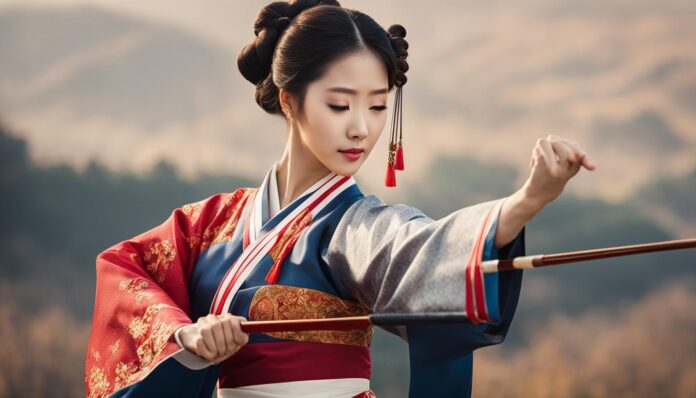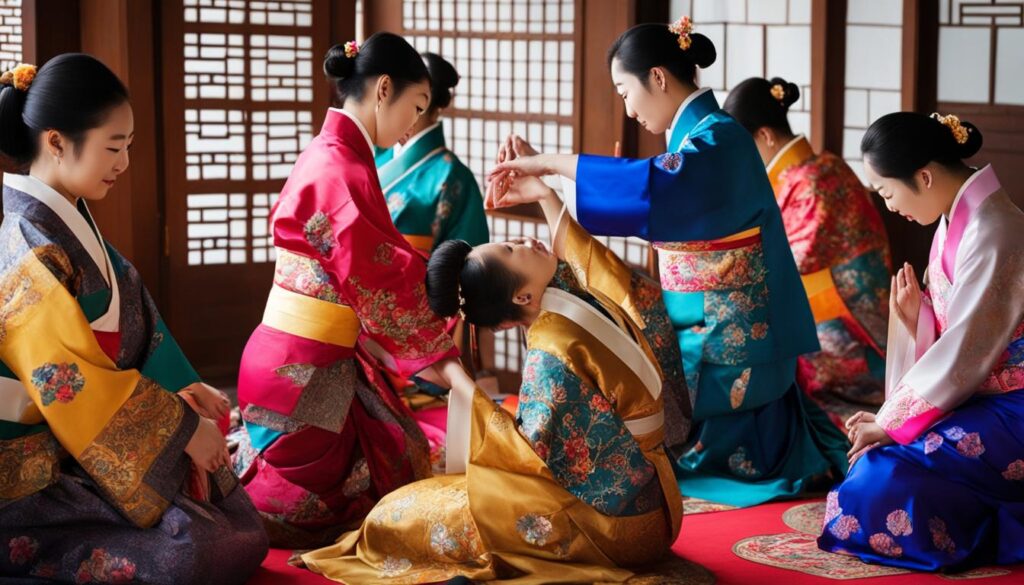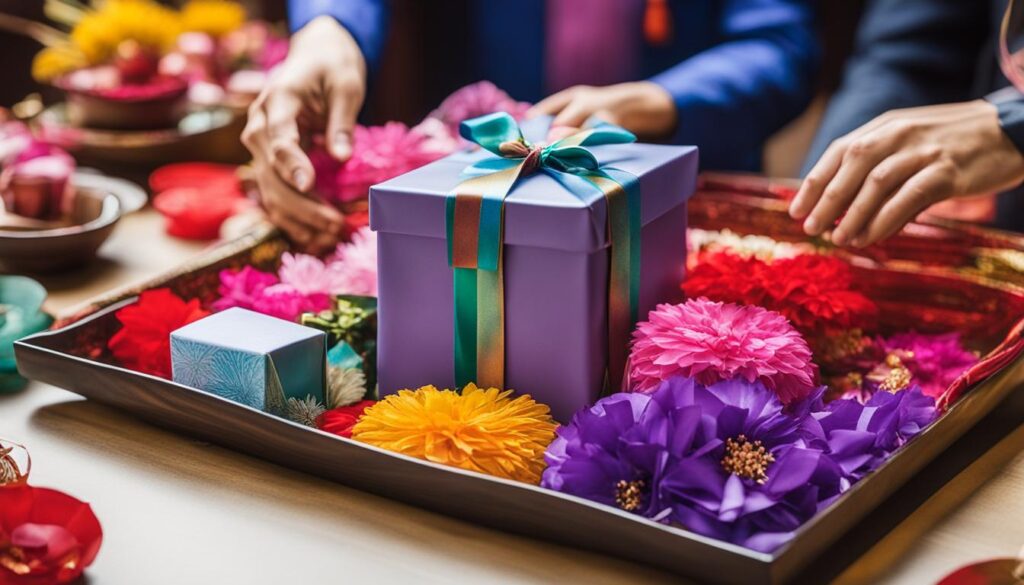If you’re planning a visit to Korea or doing business with Koreans, it’s essential to familiarize yourself with the country’s customs and etiquette. Korean culture and customs are deeply rooted in tradition and may differ significantly from what you’re used to. Knowing the basic do’s and don’ts can help you avoid misunderstandings and show respect for the local culture.
What are some common Korean customs and etiquette? In this essential guide, we’ll cover some of the most critical aspects of Korean etiquette, including social customs, dining customs, gift-giving, bowing etiquette, body language, traditional etiquette, dress code, and public transportation etiquette. By the end of this guide, you’ll have a better understanding of what to expect and how to behave in different situations, giving you the confidence to interact successfully with Koreans.
Korean Social Customs
Korea has its unique social habits and traditions that shape the relationships between people. Koreans are known for their formalities and respecting hierarchy, expressed through gestures, language, and behavior. Understanding some of these social customs can help you communicate better and avoid unintentional offense.
Greetings
When meeting someone for the first time, a handshake is common in western culture, but in Korea, a bow is more appropriate. Bowing is a sign of respect and shows your social status. To show inferiority, bow lower, while a higher status person would bow slightly to show acknowledgment.
“In Korean culture, respecting elders is an essential social norm, and ignoring it is considered disrespectful and impolite.”
Hierarchy
Korean society values social status and age dearly, and people older or in higher positions receive more respect. It is customary to address people by their title or job position rather than their names. In Korean culture, respecting elders is an essential social norm, and ignoring it is considered disrespectful and impolite.
Body Language
Koreans tend to use less hand gestures and avoid pointing; instead, they use their palms to indicate direction and express themselves through facial expressions and tone of voice. Also, it is considered rude to put your feet on public transportation seats, as Koreans are dedicated to cleanliness and sanitation.
Drinking Culture
Korean drinking culture is an important aspect of socializing in Korea, and it is customary to share drinks with friends or colleagues using shot glasses. When pouring a drink, hold the bottle with the right hand and put the left hand under the right forearm as a sign of respect and to prevent spilling any alcohol. However, excessive drinking is not encouraged and can cause embarrassment.
Table Manners
In Korean table manners, chopsticks are widely used to pick up food, but it is impolite to point them at someone or leave them vertically stuck in a dish. Unlike western cuisines, Korean meals generally include many shared plates placed on a central rotating table, and it is customary to offer food to others before serving yourself. Make sure to finish all the food on your plate as leaving food behind is interpreted as disrespect.
Korean Dining Customs
Korean dining customs are steeped in tradition and are an essential component of Korean culture. When dining with Koreans, it’s important to be aware of table manners and etiquettes to show respect and avoid causing offense. Understanding how to use chopsticks, sharing food, and the use of communal dishes are all important aspects of Korean table manners.
Using Chopsticks
Using chopsticks is common in Korea, and it’s important to use them correctly. Hold the chopsticks with your dominant hand and point them downwards, ensuring the blunt end rests on your palm, and the ends are even. When picking up food, use the tapered end of the chopsticks, and avoid stabbing or piercing food.
Sharing Food
In Korean dining culture, sharing food is a common practice, and it’s essential to do it the right way. It’s polite to use serving spoons and chopsticks to take food from communal dishes instead of using your own utensils. Serving others before yourself is an act of respect, and it’s important to wait for the eldest or most senior person at the table to begin eating before starting yourself.
Communal Dishes
Communal dishes are prevalent in Korean cuisine, and they are usually placed in the center of the table for everyone to share. There are some etiquettes to follow while using communal dishes, such as taking small portions, placing food on your plate instead of eating directly from the communal plate, and refraining from digging through the dish to find your preferred ingredients. Instead, take what is closest to you, and avoid taking the last remaining piece of food from a communal dish, as it’s considered impolite.
Korean dining customs and table manners are an integral part of Korean culture. By following these etiquettes, not only do you show respect for the traditions of Korea, but you will also enjoy a better dining experience.
Korean Bowing Etiquette
In Korean culture, bowing is an important form of greeting that shows respect and acknowledges the social hierarchy. It is essential to understand the various types of bows and the appropriate time and place to use them.
The deeper the bow, the more respect it shows. In formal situations, such as a business meeting or a formal event, a deeper bow is expected. It is also customary to bow to older people or those in a higher social position.
There are three types of bows: the informal bow, the formal bow, and the deepest bow. The informal bow is a slight nod of the head and is used in casual situations such as greeting a friend. The formal bow requires a deeper bend at the waist and is used in more formal settings such as meeting a business associate. The deepest bow involves bending at the waist until the head is at knee level and is used in the most formal situations such as meeting a high-ranking official or showing deep respect to elders.
| Type of Bow | Description | Usage |
|---|---|---|
| Informal Bow | A slight nod of the head | Casual situations, greeting friends |
| Formal Bow | A deeper bend at the waist | More formal settings, meeting business associates |
| Deepest Bow | Bending at the waist until the head is at knee level | Most formal situations, meeting high-ranking officials or showing deep respect to elders |
Bowing is often accompanied by a handshake or the exchange of business cards. It is essential to use both hands when exchanging cards and bowing slightly to show respect. Remember to use your right hand to offer or receive anything and never use your left hand as it is considered impolite.
Korean Gift-Giving Culture
Gift-giving is highly valued in Korean culture, representing gratitude, respect, and appreciation. When visiting a Korean household, it is common to prepare small gifts as a token of appreciation to show your respect to the host. In this section, we will explore the customs and etiquette associated with Korean gift-giving culture.
The emphasis on the act of gift-giving is as much on the presentation and packaging as it is on the gift itself. Koreans often wrap their gifts aesthetically, using brightly colored wrapping paper, decorated with ribbons and bows, and avoiding the use of white or black paper because they symbolize funerals and mourning, respectively.
Gifts are also usually exchanged on important occasions such as weddings, birthdays, and major holidays such as Seollal (Lunar New Year) and Chuseok (Korean Thanksgiving). Traditional and cultural items such as Hanbok (Korean traditional clothes), foods, and arts and crafts made from ceramics, wood, and silk are popular choices for gift-giving.
When presenting gifts, use both hands to show respect and hand the gift with humility and appreciation. The recipient is expected to refuse the gift initially, but do not be discouraged since it is part of Korean custom to show gratitude humbly, then accept the gift after a few more offers. Always remember to express your appreciation, respect, and gratitude for the recipient’s hospitality and kindness.
“A gift consists not in what is done or given, but in the intention of the giver or doer.” – Lucius Annaeus Seneca
Korean Body Language
When it comes to non-verbal communication, Korean body language plays a crucial role in conveying meaning and emotions. In fact, it is not uncommon for Koreans to use body language as a substitute for words. As a foreigner in Korea, understanding and interpreting the different body language cues can be challenging, but it can improve your communication with locals.
Here are some common gestures, facial expressions, and body language cues used in Korean communication:
| Gestures | Meaning |
|---|---|
| Palms facing downwards, fingers pointing to the ground | Decline or negative response |
| Thumbs up | Approval or agreement |
| Hand covering mouth while speaking or laughing | Shyness or embarrassment |
In addition to gestures, facial expressions and eye contact are also significant in Korean communication. Direct eye contact is considered an important sign of respect and attentiveness in a conversation. On the other hand, avoiding eye contact can indicate shyness or discomfort.
Understanding Korean body language is essential in interpreting the underlying messages conveyed during conversations. By learning and observing these non-verbal cues, you can gain a deeper understanding of Korean culture and smoothly navigate social situations.
Traditional Korean Etiquette
Traditional Korean etiquette is deeply rooted in the country’s history and reflects its cultural values and beliefs. Understanding and following these etiquettes demonstrate respect for Korean culture and its people. Here are some traditional Korean etiquettes that you should observe:
Respecting Elders
In Korean culture, respecting elders is highly valued and significant. The appropriate way to show respect is by bowing, using formal speech, and using specific honorific titles when addressing them. For instance, the term ‘ajumma’ refers to a middle-aged woman, and ‘ajussi’ to a middle-aged man. These titles indicate respect and acknowledgment of their age and position in society.
Addressing Others
Koreans place high importance on using the correct titles and names when addressing others. Using an inappropriate title or name can be considered disrespectful or rude. Many Koreans also use different titles based on the other person’s gender, age, and relationship with them. For instance, the word ‘oppa’ is used by younger women to address their older brothers or older male friends.
Showing Proper Manners in Various Settings
Koreans are known for their exemplary manners in various settings. For instance, removing your shoes before entering someone’s home, covering your mouth when yawning, and not blowing your nose at the table are all signs of good manners. Slurping your food or drinking soup directly from the bowl is acceptable in Korean culture, but loudly smacking your lips is not. Additionally, showing affection in public, like kissing or hugging, is not common in Korea.
Note: Observing traditional Korean etiquettes requires a willingness to learn and respect the country’s cultural values. Doing so demonstrates your interest in understanding and adapting to Korean culture, making your interactions with Koreans more enjoyable and successful.
Overall, practicing traditional Korean etiquettes is essential for anyone who wants to understand and appreciate Korean culture fully. By showing respect for the country’s cultural values and customs, you can build successful relationships with Koreans and enjoy your time in their beautiful country.
Dress Code in Korea
Adhering to the appropriate dress code is critical in showing respect for Korean customs. Korea has a unique and rigid dress code that varies depending on the occasion and setting. Below are some general dress code expectations to keep in mind.
Formal Occasions
When attending formal events, men are expected to wear dark suits, preferably in black, brown, or navy. Conservative ties and dress shoes are also required. Women should wear conservative dresses or suits. Avoid revealing outfits as modesty is highly valued in Korean culture.
Everyday Life
Korean fashion is stylish, comfortable, and modest. Clothing that is too revealing or excessively casual, such as ripped jeans or shorts, is generally not suitable for daily wear. However, casual clothing is acceptable in more informal settings, such as cafes or parks.
If you’re unsure about the dress code for a specific occasion, it’s always best to err on the side of caution and dress conservatively. Remember, dressing appropriately is a sign of respect for Korean culture and customs.
Public Transportation Etiquette
Public transportation is a popular and convenient way to get around in Korea, and it is important to follow certain etiquette rules to ensure a smooth and comfortable ride for everyone. Here are some do’s and don’ts to keep in mind:
- Do give up your seat to the elderly, disabled, and pregnant women.
- Do stand on the right side of the escalator to let others pass on the left.
- Do use headphones when listening to music or watching videos.
- Do move to the center of the car to make room for others.
- Don’t eat or drink on the train or bus.
- Don’t talk loudly on your phone or to others.
- Don’t put your bag on the seat next to you when the train or bus is crowded.
- Don’t push or shove others when getting on or off the train or bus.
Respecting personal space is essential when using public transportation. Avoid standing too close to others or blocking the doorways. If the train or bus is crowded, wait for the next one or take a taxi. By following these etiquette rules, you can ensure a pleasant and stress-free commute for everyone.
Conclusion
Now that you have gained an understanding of the essential Korean customs and etiquette, you can navigate social situations with ease while showing respect for the rich traditions of Korea. Remember, respecting the cultural nuances and adapting to local customs and practices are crucial to building successful relationships in any culture, including Korean culture.
By adhering to Korean social customs, following dining customs and table manners, using appropriate bowing etiquette, understanding gift-giving culture, familiarizing yourself with body language cues, observing traditional Korean etiquette, adhering to dress codes, and following public transportation etiquette, you can successfully interact with Koreans and show your respect for their customs.
Always keep in mind that Korean culture and customs are deeply ingrained in the people’s history and way of life. Show your appreciation for this rich culture by respecting their customs and way of life.
Remember, familiarity with Korean culture and customs takes time and effort, but the rewards of successful interactions and relationships are worth it.
So, embrace the Korean culture and customs, continue to learn and explore, and enjoy your experience in this beautiful country!

















































